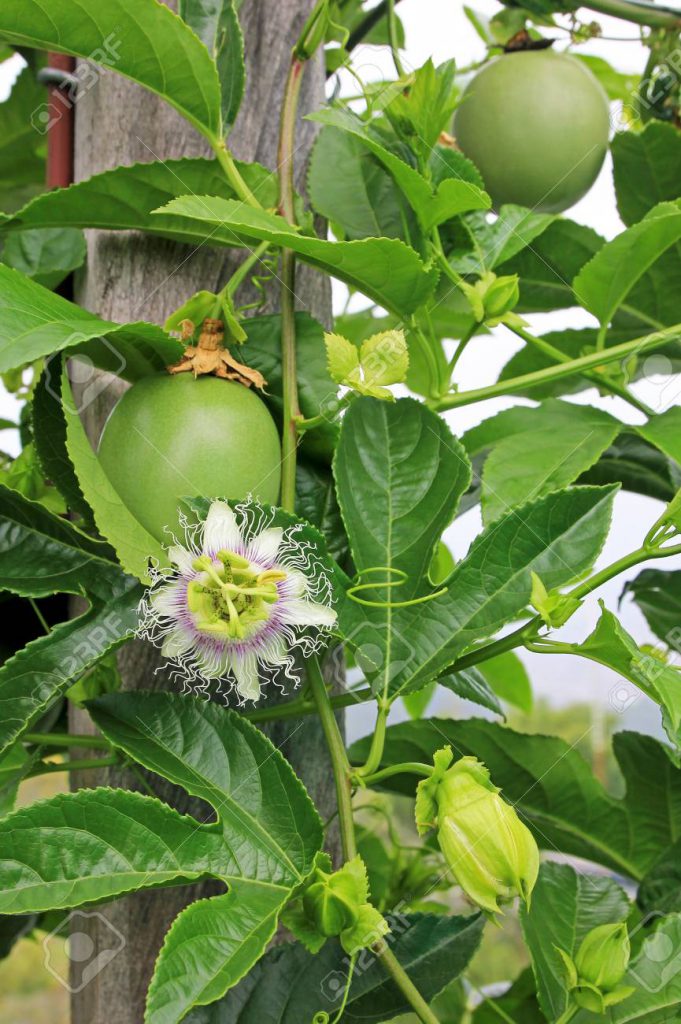
Passiflora edulis or passion fruit is a vine species of passion flower native to southern Brazil through Paraguay and northern Argentina. It is cultivated commercially in tropical and subtropical areas for its sweet, seedy fruit, commonly called passion fruit.
Frederick Passion Fruit
One of the tastiest, Frederick Passion Fruit produces an abundance of beautiful passionflowers followed by the deliciously tangy passion fruit. Stunning purple flowers give way to very large fruit that is greenish-purple sometimes turning red. Frederick can be grown outdoors in frost-free climates, though it is reportedly hardy down to 20 degrees Fahrenheit, or can be grown as an exciting greenhouse plant or windowsill where it will quickly cover a large window. What could be more exciting than fresh passion fruit growing in a south-facing window. Frederick Passion Fruit is a very vigorous vine, growing up to 30 feet in a single year in the tropics, but is easily kept smaller in a pot in temperate zones but be sure to give it something to climb up.
Passion fruit has a multitude of uses, from juices to cocktails as well as baked goods and ice cream toppings. The possibilities are endless. Add fresh passion fruit to any dish that needs some tropical sweet tang added to it! Given the difficulty of finding fresh passion fruit in most of our local markets it only makes sense to grow your own if you want to taste this tropical treat on a regular basis!
Latin Name: Passiflora edulis ‘Frederick’
Site and Soil: Passion fruit prefers full to half day sun. Well draining soil is extremely important and soil pH should be between 6.5 and 7.5 and rich in organic matter
Pollination Requirements: Frederick Passion Fruit is self-fertile
Hardiness: Frederick is reportedly hardy to 20º F., once established but we recommend giving it a frost free environment
Bearing Age: 1-2 years after planting
Size at Maturity: 20-30 feet in ground, smaller in pots
Bloom Time: Will bloom continually under ideal conditions
Ripening Time: Will fruit continually under ideal conditions
Pests & Diseases: Nematodes and snails can be a problem when passion fruit is planted in ground and is susceptible to Fusarium wilt disease
USDA Zone: 8b/9a
Growing Passion Fruit
- A spot next to a south- or west-facing wall is ideal.
- Prepare the soil in which the vine will be growing by using garden lime to raise the pH level if you have acidic soil, and consider adding compost to improve the texture and fertility of the soil. If you need to improve drainage further, add a few spadefuls of clean sand to the area.
- Passion fruits are generally either purple or yellow. Good choices for Mediterranean climates include the purple-fruiting “Frederick,” “Purple Giant” and “Red Rover” and the yellow-fruiting “Golden Giant” and “Brazilian Golden.”
- If you are growing yellow-fruited passionflower vines, be sure to grow at least two cultivars. The yellow variety needs cross-pollination to set fruit. To increase yield, use a paintbrush to transfer pollen from one vine’s flowers to the other vine’s flowers.
- If you use a hose when watering, be careful to wet the soil, not the vine itself. Wet foliage can encourage the viral diseases to which some passion fruit vines are susceptible. Consider watering in the morning to give the foliage and flowers and chance to dry in the sun.
- They produce the large edible passion fruit that are purple and will do well in the ground or a pot, best to let it fall to the ground rather than pick it.